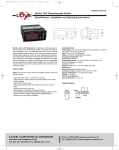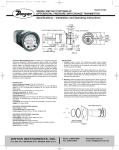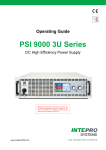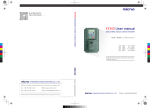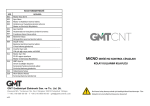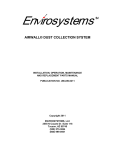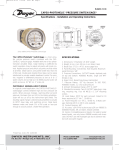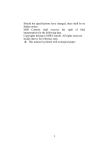Download Photohelic - UCSD Department of Physics
Transcript
B-33-A:B-33-A 8/14/09 3:02 PM Page 1 Bulletin B-33-A Series A3000 Photohelic® Differential Pressure Switch/Gage Specifications - Installation and Operating Instructions 2-1/2 [63.50] 1/8 FEMALE NPT HIGH 2-1/16 [52.39] PRESSURE CONNECTION 2 [50.80] 1/8 FEMALE NPT LOW PRESSURE CONNECTION 1-1/4 [31.75] Ø4-3/4 [120.65] 3-7/8 SQ [98.43] 3/4 CONDUIT CONNECTION (4) 6-32 HOLES EQUALLY SPACED ON A 5-1/8 [130.18] B.C. Ø4-47/64 [120.25] Ø5 [127.00] 5/8 [15.88] 3-7/8 [98.43] 5-1/8 [130.18] 5/8 [15.88] PANEL MAX 3/16 [4.76] 6-3/8 [161.93] 4-3/8 [111.13] (7-5/8 [193.68]) HOUSING REMOVAL Ø4 [101.60] FACE 5-1/2 [139.70] O.D. MOUNTING RING Fig. A NOTE: Detailed dimension drawings are available from our Customer Service Dept. for PHOTOHELIC® switch/gages as installed in two optional enclosures. For weatherproof housing, request no. 13-700132-00. /For explosion-proof housing, request no. 13-700113-01. The Series A3000 PHOTOHELIC® Switch/Gage is a versatile 2-in-1 instrument combining a time-proven Magnehelic® differential pressure gage with low/high pressure switches. It is designed to measure and control positive, negative or differential pressure of air or other non-combustible, non-corrosive gases. Gage reading is unaffected by switch operation. Switch set points are easily adjusted with knobs located on gage face. Applied pressure and switch set points are fully visible at all times. Deadband is one pointer width, less than 1% of full scale. Each set point controls a DPDT relay and both relays can be interlocked to provide variable deadband control. SPECIFICATIONS GAGE SPECIFICATIONS Service: Air and non-combustible, compatible gases. Wetted Materials: Consult factory. Accuracy: ±2% of full scale at 70°F (21.1°C). ±3% on -0 and ±4% on -00 models. Pressure Limits: -20" Hg. to 25 psig (-0.677 to 1.72 bar). MP option; 35 psig (2.41 bar), HP option; 80 psig (5.52 bar). 36003S – 36010S; 150 psig (10.34 bar). 36020S and higher;1.2 x full scale pressure. Temperature Limits: 20 to 120°F. (-6.67 to 48.9°C) Low temperature option available. Process Connections: 1/8˝ female NPT. Size: 4˝ (101.6 mm) dial face, 5˝ (127 mm) O.D. x 8-1/4˝ (209.55 mm). Weight: 4 lb (1.81 kg). SWITCH SPECIFICATIONS Switch Type: Each setpoint has 2 Form C relays (DPDT). Repeatability: ±1% of full scale. Electrical Rating: 10A @ 28 VDC, 10A @ 120, 240 VAC. Electrical Connections: Screw terminals. Use 167°F (75°C) copper conductors only. Power Requirements: 120 VAC, 50/60 Hz; 240 VAC & 24 VAC Power optional. Mounting Orientation: Diaphragm in vertical position. Consult factory for other position orientations. Set Point Adjustment: Adjustable knobs on face. Agency Approvals: UL: File No. E38121, Vol. 1, Sec. 4; CSA: File No. LR22541-34; CE: EN 61000-6-2: 1999, EN 6100-3-2: 2000, EN 61000-3-3: 2000. DWYER INSTRUMENTS, INC. P.O. BOX 373 • MICHIGAN CITY, INDIANA 46361, U.S.A. INSTALLATION 1. Location: Select a clean, dry, vibration-free location where ambient temperatures will be between 20 and 120°F (-6.67 and 48.9°C). Tubing supplying pressure to the instrument can be practically any length but long runs will increase response time slightly. 2. Position: The PHOTOHELIC® Switch/Gage is factory calibrated for use with scale in a vertical plane. Operation at other angles may affect accuracy and/or require zero adjustment. Most models can be specially calibrated at the factory for other positions if specified at time of ordering. Ranges below 1˝ W.C. must be used only with scale vertical. 3. Mounting: The PHOTOHELIC® Switch/Gage is normally mounted before making electrical connections. The electrical enclosure is removable at any time regardless of mounting method. (A) Panel Mounting: Normal mounting is flush or through panel as shown in Fig. B. Allow 4-3/8˝ (111.13 mm) clearance behind the unit for removal of electrical enclosure. Make a 4-13/16˝ (122.24 mm) diameter hole in panel. Insert the PHOTOHELIC® Switch/Gage unit from front of panel and slip mounting ring over case from behind with stepped side facing rear. Fit the snap ring into narrow groove at back edge of the bezel. Thread four 6-32 x 1-1/4˝ mounting screws into tapped holes in mounting ring and seat it against snap ring. Tighten screws against back of panel. See Fig. B. SNAP RING GROOVE Ø4-13/16 [122.24] HOLE REQUIRED FOR PANEL MOUNTING 1/2 NPT(M) PRESSURE CONNECTION. SINGLE HIGH PRESSURE CONNECTION FOR SERIES 36000S MODELS. Fig. B Phone: 219/879-8000 Fax: 219/872-9057 www.dwyer-inst.com e-mail: [email protected] B-33-A:B-33-A 8/14/09 3:02 PM Page 2 (B) Surface Mounting with Remote Relays: Where it is preferred to mount the amplifier-relay unit separate from the gage assembly, the gage is mounted as shown in Fig. B (without amplifier-relay package) or surface mounted as shown in Fig. C. Use the dimensions in Fig. D to locate holes. Fig. E Fig. C Ø3/16 TYP 4 PLACES 4-9/32 [108.74] (3) Ø3/16 [4.76] MOUNTING HOLES EQUALLY SPACED ON A 401/8 [104.78] B.C. Ø3/4 [19.05] WIRE CONNECTION HOLE 1-1/8 [25.58] 4-9/32 [108.74] 5 [127.00] SQ Fig. F 4. Pneumatic Connections & Zeroing: After installation but before making pressure connections, set the indicating pointer exactly on the zero mark, using the zero adjust screw located at the bottom of the front cover. Note that this adjustment can only be made with the high and low pressure taps both open to atmosphere. 1-1/8 [28.58] Fig. D (C) Remote Relays Mounting: On factory supplied RMR (remote mounted relay) units, the amplifier-relay package will be furnished attached to a mounting plate as shown in Fig. E. Use the hole layout in Fig. F for this option. A five foot cable assembly is included for connecting the two components. Longer cable lengths are available from the factory. Connect the high and low pressure taps to positive, negative, or differential pressure sensing points. Use 1/4˝ diameter metal or other instrument tubing and 1/8˝ NPT adapters at the PHOTOHELIC® pressure switch/gage. Adapters for rubber or soft plastic tubing are furnished with the instrument for use where this type of connection is preferred. If the PHOTOHELIC® Switch/Gage is not used to sense differential pressure, one of the pressure taps must be left open to atmosphere. This will allow the reference pressure to enter. In this case, installation of a Dwyer Instruments, Inc. No. A-331 Filter Vent Plug or similar fitting in the reference pressure tap is recommended to reduce the possibility of dust entering the instrument. NOTE: If the PHOTOHELIC® switch/gage is over pressured, pointer may “jump” from full scale back to zero and remain there until the excess pressure condition is relieved. Users should be aware of possible false zero pressure indications under this condition. B-33-A:B-33-A 8/14/09 3:02 PM Page 3 ELECTRICAL CONNECTIONS 1. Cover: The amplifier-relay unit has an easy to remove housing. Remove the three (3) screws as shown in Fig. G and slide the housing off. Make all the electrical connections before reinstalling and refastening the housing. 2. Conduit: Electrical access to the connection box portion of the relay housing is by bottom opening for 3/4˝ conduit. Use of flexible conduit is recommended. It should be supported from the panel or other suitable surface to prevent the wiring system from exerting undue strain on the instrument. See Fig. G. COVER MOUNTING SCREWS Section E contains the power connections for the control unit transformer primary. The transformer in turn supplies reduced voltage power for the LED, phototransistor, amplifier unit, and load relay pull in and hold coils. Connections must always be made to this section in order to put the unit in operation. Standard units are designed for 120 VAC input to the transformer. Special units are also available for other voltages. Separate Ground Wire attachment is provided for by a No. 6-32 screw on the mounting bracket near the conduit opening. An additional ground wire connection is located on the side of the gage body for use when the amplifier-relay unit is mounted remotely. Single Set Point instruments are furnished with the right or high set point components and circuitry in place. These are connected to Sections A and B of the terminal board. The left or low set point components are omitted. 4-3/8 [111.13] CLEARANCE FOR COVER REMOVAL FLEXIBLE CONDUIT SUPPORT CONDUIT FROM PANEL Fig. G 3. Terminal or Connection Board Layout: In Fig. H “Terminal Board,” Section A contains the connections for the load or slave relay actuated by the high or right set point. This relay is a double pole, double throw type. The two right connections are normally closed, the two middle connections are normally open, and the left connections are the common pair. The relay is in its normal or DeEnergized position when pressure is below the right hand set point. 4. Circuit Style: The PHOTOHELIC® SWITCH/GAGE is available with several factory installed optional internal circuits. They are identified as to style by a label shown in Fig. J. This label is mounted prominently on the terminal board of each instrument. The letter H denotes a circuit in which the relay can be made to latch or remain energized after pressure increase to its set point. The letter L denotes a circuit in which the relay can be made to latch or remain de-energized after pressure decrease to its set point. Two letters are required to fully identify a dual set point unit. Thus, circuit style HH, which is standard, is a dual set point circuit which has provisions for latching on pressure increase to either set point. Single relay unit or L for the special low latch unit. Units for use with other than standard 120 VAC will be so indicated on the label. Section D is exactly the same as Section A except that its load or slave relay is controlled by the low or left set point. The DeEnergized position is below the left hand pointer set point. Section B contains the external connections to the holding coil circuit for the high or right set point relay and Section C contains similar connections for the low or left set point relay. The function and use of these connections varies somewhat depending on the circuit style of the instrument. See paragraphs 5 and 6 for details. SECTION C SECTION B SECTION D SECTION A SECTION E CAUTION: Do not apply electrical current to terminals in Sections B and C. Fig. H Fig. J 5. Dual Set Point Automatic Reset: Circuit Style HH is used for simple on-off switching applications. To place in service, connect load circuits to the appropriate terminals in Section A (Fig. H) for the right set point and Section D for the left set point. Note that the N.O. contacts are open when the gage pressure pointer is to the left of the set point pointers. No connections are necessary in Sections B and C. Make external ground connections as required and connect power to Section E for the control unit. To use circuit style LL for automatic reset, a jumper wire must be installed between the two terminals in Sections B and/or C. 6. Dual Set Point Manual Reset: Circuit Style HH may also be used for manual reset applications where it is required to maintain contact on either relay following pressure increase above its set point. Load or signal connections are made to the appropriate terminals in Sections A and D (as in paragraph 5 above). Connect terminals in Sections B and C through normally closed switches or push buttons as shown in Fig. K. Use of “dry-circuit” type switches such as a Dwyer Part No. A-601 with paladium, gold, etc. or rotary wiping action type contacts is recommended. Make external ground connections as required and connect power to Section E for the control unit. B-33-A:B-33-A 8/14/09 3:02 PM Page 4 Bulletin B-33-A Circuit style LL is used for manual reset applications which require that contact be maintained following pressure decrease below the set point. Load connections are made to the appropriate terminals in Sections A and D. A normally open type manual reset switch such as Dwyer® Instruments, Inc. Part No. A-601 is connected to the terminals in Sections B and C. The circuit must be “armed by momentarily closing the switch while the black pointer is to the right of the set point. From that point on, the circuit will latch on pressure decrease below the set point and remain latched on pressure increase until manually reset with the optional switch. 11. Single Set Point Special: Manual reset after actuation on falling pressure can be obtained by using Circuit Style SRL. Consult the factory for special units and detailed instructions regarding their use. 12. Placing in Service: In normal operation each relay is de-energized when the pressure applied to the instrument is below its set point. Special low-latching units will ordinarily have to be reset before placing on the line in normal operation. RESET JUMPERS RESET NC RESET NC NO NO HI LO C NO NC NC NO C C NO NC NC NO C L2 1/3 HP* 120 V LOAD L1 CAUTION: Do not apply electrical current to terminals in Sections B and C. Manual Reset with Circuit HH *Note: For larger motors, use the Photohelic® Switch/Gage in a maintained contact, 120 Volt Control or Push Button Circuit of the motor Fig. K Fig. L 7. Dual Set Point Automatic and Manual Reset Combinations: Circuit Style HH may be used with either set point wired and operating as in paragraph 5 above and the other set point wired and operating as in paragraph 6. 8. High Low Limit Control - Dual Set Point: Circuit Style HH may be used to control fans, dampers, pumps, etc., between the set points of a PHOTOHELIC® Switch/Gage. To accomplish this, use one set point relay to reset the other as shown in the wiring diagram Fig. L. In this typical application, the load (for instance a fan) would be connected to the N.C. contacts for the right set point relay Section A (Fig. H). On pressure rise to the right set point, its relay would pull in and hold even though pressure might then fall below that set point . I the pressure continued to fall to the left set point, its relay would automatically be DE-ENERGIZED, return to its normal position and in so doing, open the holding coil circuit from Section B (Fig. H). The right set point relay would thus be reset and the cycle could repeat. 9. Dual Set Point Special Purpose Circuits: Circuit Style LL may be used where manual reset following maintained contact on pressure decrease to either set point is required. Circuit Styles HL and LH are combination units. For special combinations of features, special units, and detailed instructions regarding their use, consult the factory. 10. Single Set Point PHOTOHELIC®: The single set point PHOTOHELIC® Switch/Gage is furnished with the right set point only. Terminals in Sections A and B (Fig. H) are connected to this relay. Circuit Style SRH is wired for automatic reset as in paragraph 5 above. Manual reset is accomplished by adding a normally closed reset switch or push button to the circuit as described in paragraph 6 above. ©Copyright 2009 Dwyer Instruments, Inc. 13. Failure Mode: The PHOTOHELIC® Switch/Gage circuit design provides certain protection in the event of a loss of pressure or electrical power. In either case, both relays will de-energize, returning to their normal “zero pressure” state. The exceptions to this are models with center zero ranges. Because the relays on all standard models are always energized when the indicating (black) pointer is to the right of their respective set points, the relay action on loss of pressure will depend on set point position, since either of them could be located to the left of zero. As an example; if the left pointer were set at -2 in. w.c. and negative pressure was -3 in. w.c., a loss of that pressure would allow the black pointer to return to the center and thus cause the low set point relay to energize. If the LED should burn out, only the left-low relay will de-energize. The right-high relay will react as if pressure were above its set point and will remain energized even though pressure might be below that setting. In this situation, only termination of electrical power will allow the right-high relay to de-energize. MAINTENANCE AND SERVICE Dwyer Instruments, Inc. PHOTOHELIC® Switch/Gages are precision instruments, expertly assembled and calibrated at the factory. They require no lubrication or periodic servicing. If the interior is protected from dust, dirt, corrosive gases and fluids, years of trouble-free service may be expected. Zero adjustment should be checked and reset occasionally to maintain accuracy. The PHOTOHELIC® Switch/Gage is not field serviceable and should be returned if repair is needed (field repair should not be attempted and may void warranty). Be sure to include a brief description of the problem plus any relevant application notes. Contact customer service to receive a return goods authorization (RGA) number before shipping. Printed in U.S.A. 7/09 DWYER INSTRUMENTS, INC. P.O. BOX 373 • MICHIGAN CITY, INDIANA 46361, U.S.A. Phone: 219/879-8000 Fax: 219/872-9057 FR# 13-440202-04 Rev. 5 www.dwyer-inst.com e-mail: [email protected]




